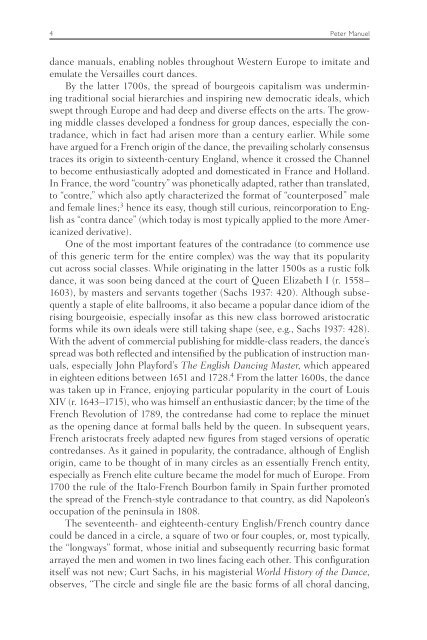Creolizing Contradance in the Caribbean - Temple University
Creolizing Contradance in the Caribbean - Temple University
Creolizing Contradance in the Caribbean - Temple University
You also want an ePaper? Increase the reach of your titles
YUMPU automatically turns print PDFs into web optimized ePapers that Google loves.
4 Peter Manuel<br />
dance manuals, enabl<strong>in</strong>g nobles throughout Western Europe to imitate and<br />
emulate <strong>the</strong> Versailles court dances.<br />
By <strong>the</strong> latter 1700s, <strong>the</strong> spread of bourgeois capitalism was underm<strong>in</strong><strong>in</strong>g<br />
traditional social hierarchies and <strong>in</strong>spir<strong>in</strong>g new democratic ideals, which<br />
swept through Europe and had deep and diverse effects on <strong>the</strong> arts. The grow<strong>in</strong>g<br />
middle classes developed a fondness for group dances, especially <strong>the</strong> contradance,<br />
which <strong>in</strong> fact had arisen more than a century earlier. While some<br />
have argued for a French orig<strong>in</strong> of <strong>the</strong> dance, <strong>the</strong> prevail<strong>in</strong>g scholarly consensus<br />
traces its orig<strong>in</strong> to sixteenth-century England, whence it crossed <strong>the</strong> Channel<br />
to become enthusiastically adopted and domesticated <strong>in</strong> France and Holland.<br />
In France, <strong>the</strong> word “country” was phonetically adapted, ra<strong>the</strong>r than translated,<br />
to “contre,” which also aptly characterized <strong>the</strong> format of “counterposed” male<br />
and female l<strong>in</strong>es; 3 hence its easy, though still curious, re<strong>in</strong>corporation to English<br />
as “contra dance” (which today is most typically applied to <strong>the</strong> more Americanized<br />
derivative).<br />
One of <strong>the</strong> most important features of <strong>the</strong> contradance (to commence use<br />
of this generic term for <strong>the</strong> entire complex) was <strong>the</strong> way that its popularity<br />
cut across social classes. While orig<strong>in</strong>at<strong>in</strong>g <strong>in</strong> <strong>the</strong> latter 1500s as a rustic folk<br />
dance, it was soon be<strong>in</strong>g danced at <strong>the</strong> court of Queen Elizabeth I (r. 1558–<br />
1603), by masters and servants toge<strong>the</strong>r (Sachs 1937: 420). Although subsequently<br />
a staple of elite ballrooms, it also became a popular dance idiom of <strong>the</strong><br />
ris<strong>in</strong>g bourgeoisie, especially <strong>in</strong>sofar as this new class borrowed aristocratic<br />
forms while its own ideals were still tak<strong>in</strong>g shape (see, e.g., Sachs 1937: 428).<br />
With <strong>the</strong> advent of commercial publish<strong>in</strong>g for middle-class readers, <strong>the</strong> dance’s<br />
spread was both reflected and <strong>in</strong>tensified by <strong>the</strong> publication of <strong>in</strong>struction manuals,<br />
especially John Playford’s The English Danc<strong>in</strong>g Master, which appeared<br />
<strong>in</strong> eighteen editions between 1651 and 1728. 4 From <strong>the</strong> latter 1600s, <strong>the</strong> dance<br />
was taken up <strong>in</strong> France, enjoy<strong>in</strong>g particular popularity <strong>in</strong> <strong>the</strong> court of Louis<br />
XIV (r. 1643–1715), who was himself an enthusiastic dancer; by <strong>the</strong> time of <strong>the</strong><br />
French Revolution of 1789, <strong>the</strong> contredanse had come to replace <strong>the</strong> m<strong>in</strong>uet<br />
as <strong>the</strong> open<strong>in</strong>g dance at formal balls held by <strong>the</strong> queen. In subsequent years,<br />
French aristocrats freely adapted new figures from staged versions of operatic<br />
contredanses. As it ga<strong>in</strong>ed <strong>in</strong> popularity, <strong>the</strong> contradance, although of English<br />
orig<strong>in</strong>, came to be thought of <strong>in</strong> many circles as an essentially French entity,<br />
especially as French elite culture became <strong>the</strong> model for much of Europe. From<br />
1700 <strong>the</strong> rule of <strong>the</strong> Italo-French Bourbon family <strong>in</strong> Spa<strong>in</strong> fur<strong>the</strong>r promoted<br />
<strong>the</strong> spread of <strong>the</strong> French-style contradance to that country, as did Napoleon’s<br />
occupation of <strong>the</strong> pen<strong>in</strong>sula <strong>in</strong> 1808.<br />
The seventeenth- and eighteenth-century English/French country dance<br />
could be danced <strong>in</strong> a circle, a square of two or four couples, or, most typically,<br />
<strong>the</strong> “longways” format, whose <strong>in</strong>itial and subsequently recurr<strong>in</strong>g basic format<br />
arrayed <strong>the</strong> men and women <strong>in</strong> two l<strong>in</strong>es fac<strong>in</strong>g each o<strong>the</strong>r. This configuration<br />
itself was not new; Curt Sachs, <strong>in</strong> his magisterial World History of <strong>the</strong> Dance,<br />
observes, “The circle and s<strong>in</strong>gle file are <strong>the</strong> basic forms of all choral danc<strong>in</strong>g,
















